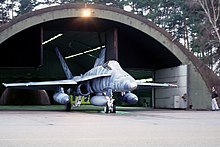Canada in the Cold War
Subsequent peacekeeping interventions occurred in the Congo (1960), Cyprus (1964), the Sinai (1973), Vietnam (with the International Control Commission), Golan Heights, Lebanon (1978), and Namibia (1989–1990).
The peak moments of this effort were the Winnipeg General Strike of 1919 and the anticommunist campaigns of the depression, including the stopping of the On-to-Ottawa Trek.
[1][2][note 1] Canada was a founding member of NATO (North Atlantic Treaty Organization), of which Prime Minister Louis St. Laurent was a chief architect.
PROFUNC was a Government of Canada top secret plan to identify and detain Communist sympathizers during the height of the Cold War.
In the Korean War, the moderately sized contingent of volunteer soldiers from Canada made noteworthy contributions to the United Nations forces and served with distinction.
Although a United Nations military force had been proposed and advocated for the preservation of peace vis a vis the U.N.'s mandate by Canada's representatives Prime Minister Mackenzie King and his Secretary of State for External Affairs Louis St. Laurent at the United Nations Conference on International Organization in San Francisco in June 1945, it was not adopted at that time.
Diefenbaker had already agreed to buy the BOMARC missile system from the Americans, which would be not as effective without nuclear warheads, but balked at permitting the weapons into Canada.
[13] It would only be after a tense phone call between President John F. Kennedy and Diefenbaker that Canada's armed forces would begin preparations for "immediate enemy attack.
Further tensions developed when Pearson criticized the American role in the Vietnam War in a speech he gave at Temple University in Philadelphia, Pennsylvania.
[15] During this period, Canada played a middle power role in international affairs, and pursued diplomatic relations with Communist countries that the US had severed ties with, such as Cuba and Red China after their respective revolutions.
Canada also refused to join the Organization of American States, disliking the support and tolerance of the Cold War OAS for dictators.
[16] Prime Minister Brian Mulroney and President Ronald Reagan had a close relationship, but the 1980s also saw widespread protests against American testing of cruise missiles in Canada's north.
Yakovlev then returned to Moscow, and would eventually be called the "godfather of glasnost,"[18] the intellectual force behind Gorbachev's reform program.In 1987, Canada released a long-awaited White Paper on Defence;[19] signalling its intent to re-assert sovereignty over its Arctic waters.
Project Spinnaker was born, a joint Canada–US endeavour whose secret purpose was to provide the capability to monitor submarine traffic in Canadian Arctic waters by deploying acoustic listening posts on the seafloor.
This project required the development of a large autonomous underwater vehicle—named Theseus—whose sole purpose was to lay communications trunk cables on the seafloor in waters with a permanent ice cover.
When the Cold War ended, Canadian Forces were withdrawn from their NATO commitments in Germany, military spending was cut, and air raid sirens were removed across the country.
At home, bases were closed and operations consolidated and streamlined for maximum efficiency, as by the early 1990s many Canadians were openly questioning the necessity of large defence budgets.
In 1993 Balkan involvement expanded into Bosnia and Canadian troops participated in some of the fiercest combat since the Korean War during Operation Medak Pocket.
The Army began to acquire new equipment, such as the LAV-III, Bison APC and the Coyote Reconnaissance Vehicle as it transitioned to fighting irregular warfare instead of the large tank battles once feared would rage across Western Europe.
In recent years, Canada has been involved in tensions with Russia following the takeover of Crimea from Ukraine and China due to its diplomatic spat over various issues such as treatment of Uyghurs, Meng Wenzhou and Hong Kong protests.







